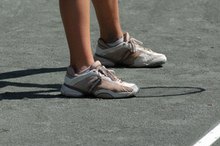Causes of Fatigue & Aching Legs
Many medical conditions can cause both pain in the legs and fatigue, and determining the cause of these symptoms often requires a trip to the doctor. To make a diagnosis, your doctor needs a thorough understanding of your symptoms, including what brings them on, what improves them, and other symptoms you may have.
If you are experiencing serious medical symptoms, seek emergency treatment immediately.
Overtraining
Overtraining is a type of overexertion that can cause both fatigue and muscle aches. It is usually seen in competitive athletes, but according to the June 2003 issue of "The Physician and Sports Medicine," it can occur in ordinary fitness enthusiasts who exercise intensely over an extended period of time. Overtraining may also affect someone who drastically increases their level of activity after a long period of inactivity. Other symptoms of overtraining may include irritability, insomnia, anxiety and increased susceptibility to infections.
- Overtraining is a type of overexertion that can cause both fatigue and muscle aches.
Circulation Causes
Circulation Problems in the Arm
Learn More
Disorders that reduce blood flow to the legs can cause aching legs and fatigue. Peripheral artery disease (PAD) is one of the most common causes of decreased circulation in the legs. PAD is caused by atherosclerotic plaques that block arteries in the legs, similar to the plaques that block arteries of the heart in coronary artery disease. PAD classically causes leg pain while walking or climbing stairs, which improves with rest. People frequently notice an overall feeling of fatigue as well. PAD typically affects older individuals who are current or past cigarette smokers and who have other cardiovascular disease risk factors, such as high cholesterol and diabetes. PAD is particularly important because it is a sign of possible heart disease. People with PAD often have coronary artery disease as well.
- Disorders that reduce blood flow to the legs can cause aching legs and fatigue.
- People with PAD often have coronary artery disease as well.
Inflammatory Disorders
Disorders causing inflammation may produce pain in the areas of inflammation, as well as generalized symptoms such as fatigue or fever. Polymyalgia rheumatica is an inflammatory disorder that causes pain and stiffness in multiple muscles and joints 5. It can cause aching legs and fatigue. Other symptoms may include a mild fever, general feeling of being unwell, depression, loss of appetite and unintended weight loss. Polymyalgia rheumatica typically affects older people and is more common in those of northern European ancestry 5. It affects women more often than men. About 20 percent of people with polymyalgia rheumatica also have giant cell arteritis, according to a review article in the October 2017 issue of "The Lancet." This is a serious inflammatory disorder affecting arteries 5. Temporal arteries -- located on each side of the forehead -- are often involved, leading to headaches, jaw pain, vision changes and sometimes blindness or a stroke.
Fibromyalgia and Chronic Fatigue Syndrome
Causes of Burning Calf Pain
Learn More
Fibromyalgia and chronic fatigue syndrome (CFS) are two related disorders 2. Fatigue, headaches, muscle aches and sleep disturbance are among the symptoms common to both disorders. In fibromyalgia, pain symptoms tend to be more prominent, whereas in CFS, fatigue and flu-like symptoms are more obvious. Depression is quite common with both disorders, and treating this depression may improve other symptoms.
Reviewed by: Mary D. Daley, MD
- Fibromyalgia and chronic fatigue syndrome (CFS) are two related disorders 2.
- In fibromyalgia, pain symptoms tend to be more prominent, whereas in CFS, fatigue and flu-like symptoms are more obvious.
Related Articles
References
- The Physician and Sports Medicine: Overtraining Syndrome -- A Guide to Diagnosis, Treatment and Prevention
- International Journal of Rheumatic Diseases: Fibromyalgia and Chronic Fatigue Syndrome
- Leg Pain; Magruder Donaldson, MD
- Indian Journal of Medical Research: Diagnosis of Polymyalgia Rheumatica Usually Means a Favourable Outcome for Your Patient
- The Lancet: Polymyalgia Rheumatica
- "Questions and Answers about Polymyalgia Rheumatica and Giant Cell Arteritis." National Institute of Arthritis and Musculoskeletal and Skin Diseases. April 2010.
- Dasgupta B. et al. "2012 Provisional Classification Criteria for PolymyalgiaRrheumatica: A European League Against Rheumatism/American College of Rheumatology collaborative initiative." Arthritis & Rheumatism. April 2012. doi:10.1136/annrheumdis-2011-200329
- Docken, MD., WP. "Polymyalgia Rheumatica." American College of Rheumatology. Updated August 2009.
- Klippel J. et al. "Primer on the Rheumatic Diseases. Polymyalgia Rheumatica." Pages 404-406. Thirteenth Edition. Arthritis Foundation.
Writer Bio
Sydney Hornby specializes in metabolic disease and reproductive endocrinology. He is a graduate of Claremont McKenna College and Drexel University College of Medicine in Philadelphia, where he earned his M.D., and has worked for several years in academic medical research. Writing for publication since 1995, Hornby has had articles featured in "Medical Care," "Preventive Medicine" and "Medical Decision Making."








